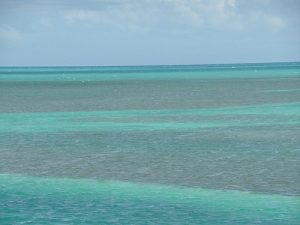Between the islands and barrier reef of the Florida Keys are grassy shallows, patch reefs and isolated coral heads. Though these hazards show on nautical charts, changes occur between publications. One skill you can learn to help avoid these dangers is eyeball navigation, a method of reading water depth and bottom composition based on Florida Keys Water Colors. Having this skill goes a long way toward avoiding boats going aground in places with clear, shallow water like the Florida Keys. For recent arrivals, this will be a new but vital skill to develop for navigating these waters. The majority of natural hazards are not identified with markers, so you must learn to recognize them by eye. The good news is that it is not hard to learn with a little practice.
 The general range of color going from shallow to deep water is as follows: yellow to whitish is for shallow sand, brown or brownish-red represents shallow rock or grassy beds, dark fuzzy-outlined patches are usually grass, and sharply-outlined black or beige are coral heads. Sometimes coral will also have sand rings around the base of the heads. The deeper the water, the more it goes from light green to dark green to blue. If you go far enough out, you’ll be in the deep indigo waters of the Straits of Florida. Ideal conditions for eyeball navigation consist of a clear sky, with the sun high and behind you, while you wear polarized sunglasses to cut surface glare. Under these circumstances you can read the water well ahead of time to avoid any dangers. In reality, the best conditions do not always come into alignment.
The general range of color going from shallow to deep water is as follows: yellow to whitish is for shallow sand, brown or brownish-red represents shallow rock or grassy beds, dark fuzzy-outlined patches are usually grass, and sharply-outlined black or beige are coral heads. Sometimes coral will also have sand rings around the base of the heads. The deeper the water, the more it goes from light green to dark green to blue. If you go far enough out, you’ll be in the deep indigo waters of the Straits of Florida. Ideal conditions for eyeball navigation consist of a clear sky, with the sun high and behind you, while you wear polarized sunglasses to cut surface glare. Under these circumstances you can read the water well ahead of time to avoid any dangers. In reality, the best conditions do not always come into alignment.
Sometimes a high, thin cloud cover exists, which still allows for reading the bottom, but with a reduction in range and detail. At other times, you may be returning a bit later in the day with the sun lower and more ahead than is preferable. Partly cloudy afternoons with thick cumulus clouds are tricky. The light alternates from full sun to heavy shade every time the sun passes behind the next cloud, so take a mental snapshot of what’s ahead before arriving at the next shady section. Circumstances can and do change during the day. These variations in water reading conditions are mentioned not to discourage you, but to paint a realistic picture of the variables. Just keep these factors in mind when planning. Steer clear of trickier situations if things look marginal, and adjust your itinerary if conditions change. Remember to look back in
Remember to look back in shallow water to make sure you’re not stirring up the bottom. Coral and seagrass are fragile and learning to eyeball navigate is a skill you can learn to protect our natural resources, and your boat, from damage. You can head out on the water from the ramps at John Pennekamp Coral Reef State Park and Bahia Honda State Park. A great place to start is by visiting floridastateparks.org to plan your trip out on the beautiful Florida Keys water.
Chris Lamond is a park ranger at John Pennekamp Coral Reef State Park.
“Brown, brown, run aground.
White, white, you just might.
Blue, blue, sail on through.
Green, green, nice and clean.”
